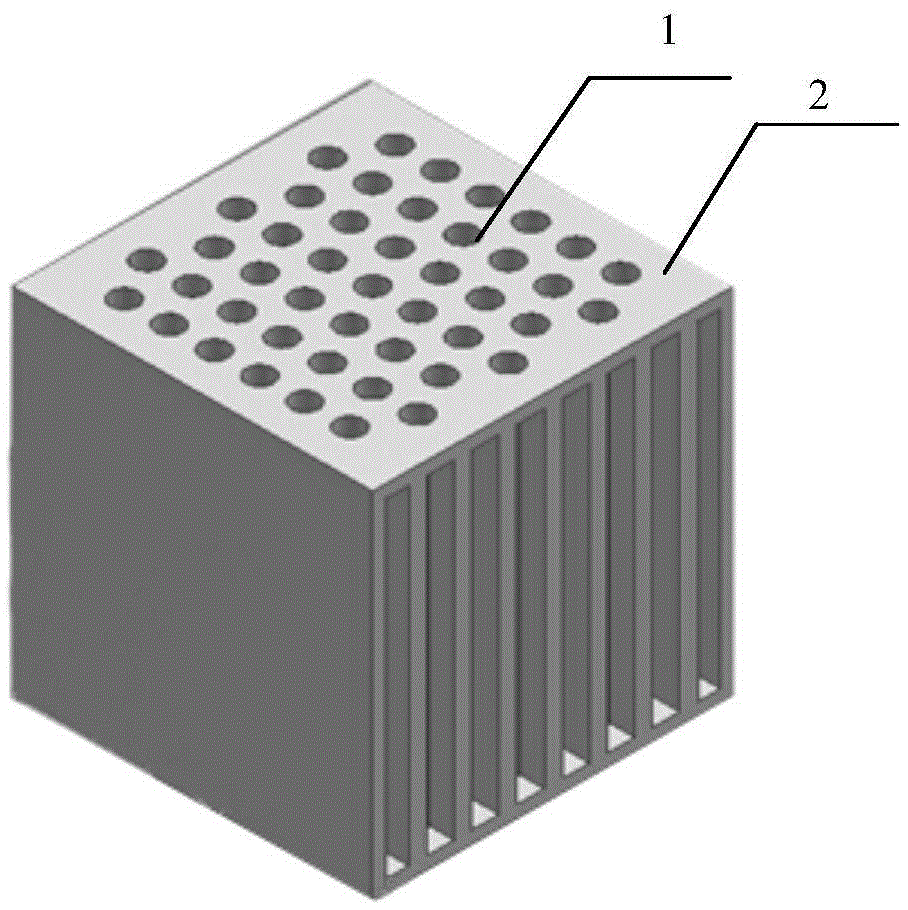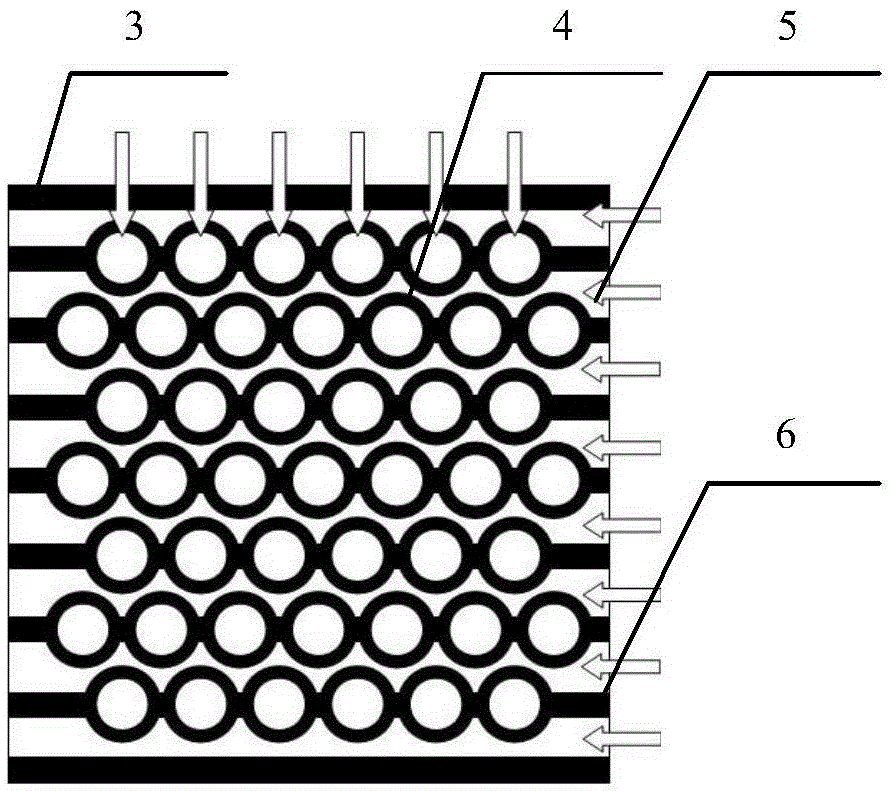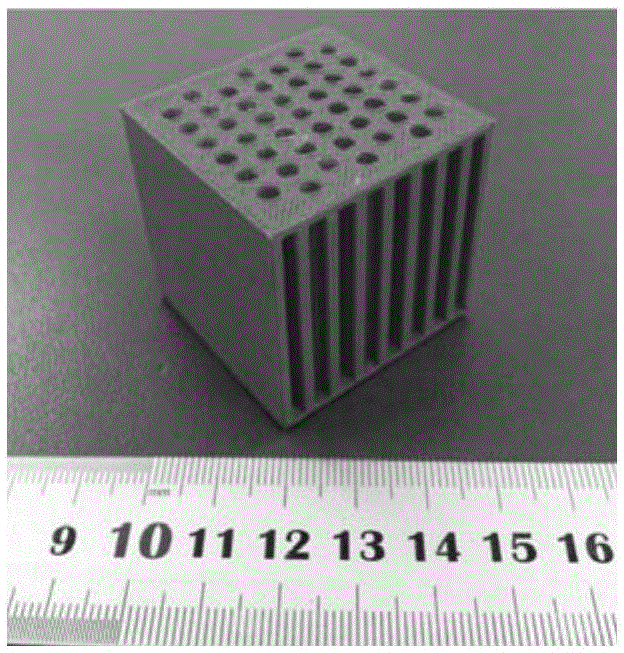Three-dimensional printing method for honeycomb type electric catalyzing membrane reactor with three-dimensional channel
An electrocatalytic membrane and three-dimensional printing technology, applied in applications, electrolysis processes, household appliances, etc., can solve problems such as high cost, unstable batch performance, and reduced mass transfer efficiency, so as to reduce the impact of product quality and save production. cost, the effect of improving production efficiency
- Summary
- Abstract
- Description
- Claims
- Application Information
AI Technical Summary
Problems solved by technology
Method used
Image
Examples
Embodiment 1
[0044] Add 300gYSZ(Y 0.08 Zr 0.92 O 2-δ ) The ceramic powder and 10g dextrin are uniformly mixed with a blender, and placed in a three-dimensional printer raw material box after passing through a 60-mesh sieve. The three-dimensional printer adopts the Z510 ceramic three-dimensional printer from Zcorp, USA, and uses ug software to draw the three-dimensional solid model structure diagram of the electrocatalytic membrane reactor, see figure 1 , A computer-controlled three-dimensional printer is used to print the YSZ ceramic powder according to the designed three-dimensional solid model structure drawing to obtain a green honeycomb electrolyte support body with a three-dimensional channel structure. The external dimensions of the model are 4cm in length, width, and height. There are 45 ceramic microtubes in the longitudinal direction, which provide fluid channels on the tube side, and 8 channels in the transverse direction, which provide fluid channels between the tubes. See the pho...
Embodiment 2
[0048] 400gGDC(Gd 0.1 Ce 0.9 O 2-δ ) The ceramic powder and 20 g of polyvinyl butyral are uniformly mixed with a blender, passed through a 60-mesh sieve, and placed in a three-dimensional printer raw material box. The three-dimensional printer adopts the Z510 ceramic three-dimensional printer from Zcorp, USA, and uses 3Dmax software to draw the three-dimensional solid model structure diagram of the electrocatalytic membrane reactor, see figure 1 , Use a computer to control a three-dimensional printer to print the GDC ceramic powder according to the designed three-dimensional solid model structure drawing to obtain a green honeycomb ceramic electrolyte support body with a three-dimensional channel structure. The external dimensions of the model are 4cm in length, width, and height. There are 45 ceramic microtubes in the longitudinal direction, which provide fluid channels on the tube side, and 8 channels in the transverse direction, which provide fluid channels between the tubes....
Embodiment 3
[0052] Add 350gSDC(Sm 0.2 Ce 0.8 O 2-δ ) The ceramic powder and 20 g of the polyethersulfone solution are uniformly mixed with a blender, passed through a 60-mesh sieve, and placed in a three-dimensional printer raw material box. The three-dimensional printer adopts the Z510 ceramic three-dimensional printer from Zcorp Company, and uses catia software to draw the three-dimensional solid model structure diagram of the electrocatalytic membrane reactor, see figure 1 Using a computer-controlled three-dimensional printer to print the SDC ceramic powder according to the designed three-dimensional solid model structure drawing to obtain a green honeycomb ceramic electrolyte support body with a three-dimensional channel structure. The external dimensions of the model are 4cm in length, width, and height. There are 45 ceramic microtubes in the longitudinal direction, which provide fluid channels on the tube side, and 8 channels in the transverse direction, which provide fluid channels b...
PUM
| Property | Measurement | Unit |
|---|---|---|
| particle size | aaaaa | aaaaa |
| thickness | aaaaa | aaaaa |
| thickness | aaaaa | aaaaa |
Abstract
Description
Claims
Application Information
 Login to View More
Login to View More - R&D
- Intellectual Property
- Life Sciences
- Materials
- Tech Scout
- Unparalleled Data Quality
- Higher Quality Content
- 60% Fewer Hallucinations
Browse by: Latest US Patents, China's latest patents, Technical Efficacy Thesaurus, Application Domain, Technology Topic, Popular Technical Reports.
© 2025 PatSnap. All rights reserved.Legal|Privacy policy|Modern Slavery Act Transparency Statement|Sitemap|About US| Contact US: help@patsnap.com



